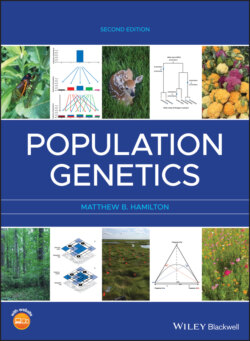Читать книгу Population Genetics - Matthew B. Hamilton - Страница 52
Chapter 2 review
ОглавлениеMendel's experiments with peas lead him to hypothesize particulate inheritance with independent segregation of alleles within loci and independent assortment of multiple loci.
Expected genotype frequencies predicted by the Hardy–Weinberg equation (for any number of alleles) show that Mendelian inheritance should lead constant allele frequencies across generations. This prediction has a large set of assumptions about the absence of many population genetic processes. Hardy–Weinberg expected genotype frequencies therefore serve as a null model used as a standard of reference.
The null model of Hardy–Weinberg expected genotype frequencies can be tested directly or assumed to be approximately true in order to test other hypotheses about Mendelian inheritance.
The fixation index (F) measures departures from Hardy–Weinberg expected genotype frequencies (excess or deficit of heterozygotes) that can be caused by patterns of mating.
Mating among relatives or consanguineous mating causes changes in genotype frequencies (specifically a decrease in heterozygosity) but usually no changes in allele frequencies.
Mating among relatives is a process that increases the autozygosity or chance that alleles descended from a common ancestor are found together in a diploid genotype.
The coancestry coefficient gives the probability that an allele sampled from each of two individuals is identical by descent, defining relatedness between individuals.
The fixation index, the coancestry coefficient, and autozygosity are all interrelated measures of changes in genotype frequencies due to consanguineous mating.
Mating among relatives alters mean phenotypes because homozygosity increases.
An increase in homozygosity leads to inbreeding depression, which ultimately is caused by overdominance (heterozygote advantage) or dominance (deleterious recessive alleles).
The gametic disequilibrium parameter (D) and its correlation version (ρ) measure the degree of association of alleles paired at two loci compared with random pairing. Gametic disequilibrium is broken down by recombination, decaying by the maximum of 50% per generation when loci experience free recombination.
A wide variety of population genetic processes – natural selection, chance, admixture of populations, mating system, and mutation – can maintain and increase gametic disequilibrium even between loci without physical linkage to reduce recombination.
